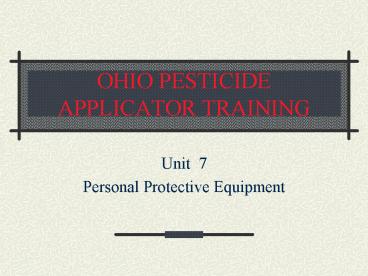OHIO PESTICIDE APPLICATOR TRAINING - PowerPoint PPT Presentation
1 / 13
Title:
OHIO PESTICIDE APPLICATOR TRAINING
Description:
PPE Clothing and devices that are worn to protect the human body from contact with pesticides or pesticide residue Types of PPE Coveralls Aprons YOU ARE LEGALLY ... – PowerPoint PPT presentation
Number of Views:260
Avg rating:3.0/5.0
Title: OHIO PESTICIDE APPLICATOR TRAINING
1
OHIO PESTICIDE APPLICATOR TRAINING
- Unit 7
- Personal Protective Equipment
2
The Ohio State University Extension
- David J. Goerig
- Ag / Natural Resource Agent
- Mahoning County
3
What is Personal Protective Equipment?PPE
- Clothing and devices that are worn to protect
the human body from contact with pesticides or
pesticide residue
4
Types of PPE
- Coveralls
- Aprons
- Respirators
- Protective suits
- Eyewear
- Footwear
- Gloves
- Headwear
5
YOU ARE LEGALLY REQUIRED TO FOLLOW ALL PERSONAL
PROTECTIVE EQUIPMENT INSTRUCTIONS THAT APPEAR ON
THE LABEL OR IN LABELING
6
Factors affecting the Chemical Resistance of PPE
- Length of exposure
- Exposure situation
- Type of Chemical
- Type of Material
7
Choosing Chemical-Resistant Materials
- Cotton, Leather, and Canvas are not chemical
resistant.
- The best choice materials include but are not
limited to Rubber, plastic, butyl, neoprene,
and polyvinyl chloride products.
8
Hand and Foot Protection
- Areas of most exposure.
- Avoid contamination.
- Must be chemical resistant to the product you
are working with.
- Must be worn correctly.
- In good condition.
- Cleaned / Replaced often.
9
Head and Neck Protection
- Required if you will be exposed to pesticides
from above.
- Wide brimmed Safari hats are good.
- Resistant to the chemical you are working with.
- Jackets with attached hoods available
10
Protecting your Eyes
- Safety glasses OK if they include brow and side
shields.
- Goggles
- Face shields
11
Protecting your Respiratory Tract
- Dust / Mist filtering respirators
- Vapor-removing respirators
- Air-supplying respirators
12
Handling Fumigants
- Applied in a gaseous state.
- Highly toxic.
- Never work alone.
- Respirator required.
- Breathable fabrics.
13
Maintaining PPE
- Wear gloves, goggles and aprons when handling
pesticide contaminated equipment.
- Work in well ventilated area.
- Rinse first.
- Wash with detergent and hot water.
- Rinse twice.
- Air dry.































